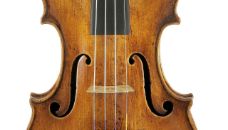Violin, Santo Serafin, Venice, 1733
Copperplate engraved label with garlands and figurative representations: “Sanctus Seraphin / Utinensis Fecit / Venetijs Anno 1733” (33 handwritten)This violin is an example of Serafin’s early work, made shortly after he had settled in Venice and opened shop. The body model is very slender with typical, wide open f-holes. The divided belly has very regular, medium-wide annual rings. The one-piece maple back shows vivid, wide flames. The wood of the ribs exhibits a similar structure. By contrast, the pegbox and scroll are only faintly flamed. The belly has a medium-high arch; the arching of the back is much lower by comparison. The design of the very upright f-holes is clearly modeled on Amati’s style. The curves are harmoniously shaped; the proportions of the f-hole eyes and wings are well matched. Serafin’s superior craftsmanship is also evident in the purfling: The wide, light-colored middle strip is flanked by two narrow, dark strips, giving the purfling a delicate appearance that is further enhanced by the clean handling of the edges and corners. The volutes of the scroll are more deeply undercut than on later instruments. Santo Serafin applied a very attractive, medium-brown varnish over a light, transparent ground. The varnish profile can easily be made out, especially on the back of the instrument.
arched arching back belly body channel dendrochronological f-holes flames flaming label model mold neck pegbox purfling quarter-cut ribs scroll slab-cut varnish
Stradivari Giovanni Battista Guadagnini Carlo Michelangelo Bergonzi Guarneri del Gesù Stainer Santo Serafin






